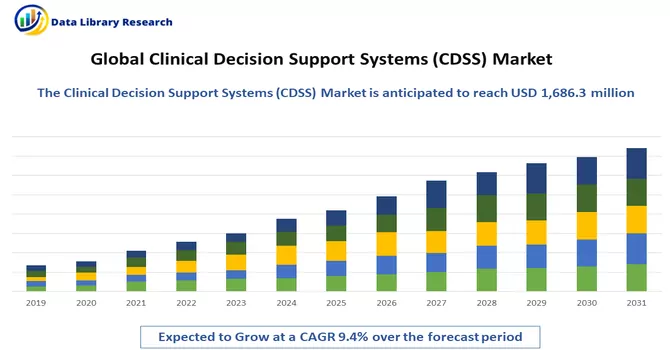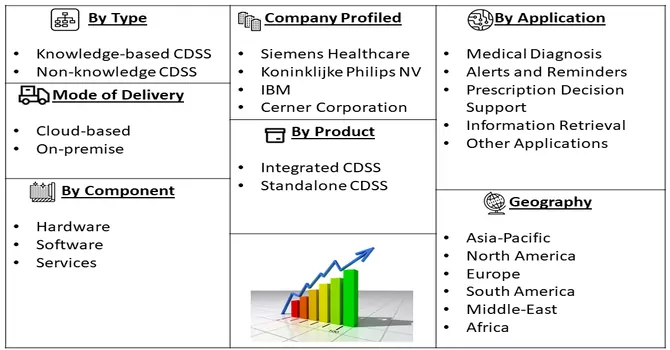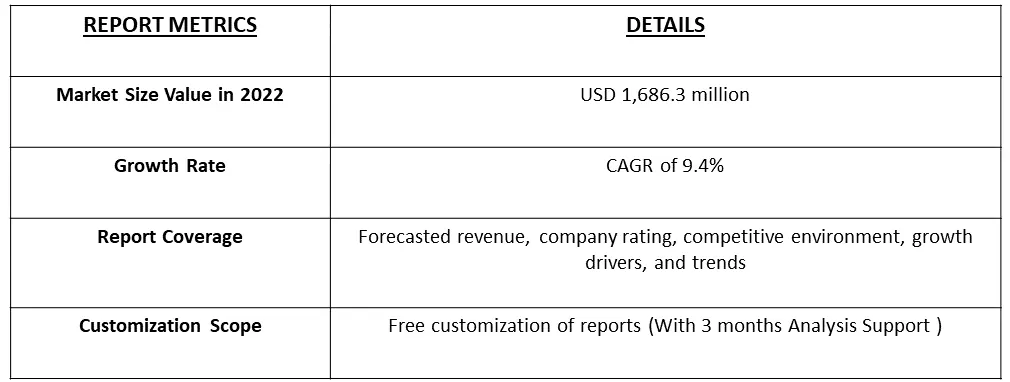The clinical decision support systems (CDSS) market was valued at approximately USD 1,686.3 million in the year, 2022 and is expected to register a CAGR of nearly 9.4% during the forecast period, 2023-2030.

Get Complete Analysis Of The Report - Download Free Sample PDF
Clinical Decision Support Systems (CDSS) are computer-based tools and technologies designed to assist healthcare professionals, including doctors, nurses, and pharmacists, in making informed and evidence-based decisions about patient care. These systems are integrated into healthcare information systems, such as Electronic Health Records (EHRs), and provide real-time information and knowledge to aid in clinical decision-making. CDSS aims to improve the quality of care, enhance patient safety, and optimize healthcare processes by providing relevant clinical information and recommendations.
The rising demand for reducing healthcare expenditure, the need for improvement in the quality of care, and technological advancements in healthcare IT in hospitals are the major factors that are likely to boost the growth of the clinical decision support systems (CDSS) market.
Segmentation:
The Global Clinical Decision Support Systems (CDSS) Market is Segmented
By Model :
Mode of Delivery :
Component :
Product :
Application :
Geography :
The report offers the value (in USD million) for the above segments.

For Detailed Market Segmentation - Download Free Sample PDF
The Clinical Decision Support System (CDDS) market continues to evolve as it becomes an integral part of modern healthcare systems. CDSS is increasingly used to manage the health of entire patient populations. By analyzing aggregated data from multiple sources, including EHRs and other health records, CDSS can identify trends, risk factors, and opportunities for improving healthcare outcomes for large groups of patients. Also, CDSS is playing a crucial role in the growth of personalized medicine. It assists in tailoring treatment plans to individual patients based on their genetic, clinical, and demographic data. This trend is especially relevant in oncology, where specific genetic information guides treatment decisions.
Driver:
Technological Advancement in Healthcare IT in Hospital
Technological advancements in healthcare IT are driving improvements in patient care, safety, and efficiency within hospitals. Hospitals that embrace these innovations are better positioned to provide high-quality care and improve the overall patient experience. It's important to note that the adoption of these technologies may vary by region and healthcare facility, but the overall trend is toward increased digitalization and integration of technology in healthcare. Moreover, the Internet of Things (IoT) and wearable devices can continuously monitor patients' vital signs and health metrics. Hospitals are incorporating IoT devices to improve patient outcomes, reduce hospital stays, and manage chronic conditions more effectively.
Need for Improvement in Quality of Care and Reducing Human Errors
The need for improvement in the quality of care and a reduction in human errors in healthcare is driving the growth of the Clinical Decision Support Systems (CDSS) market. CDSS is built upon evidence-based medical knowledge. It assists healthcare professionals by providing access to the latest clinical guidelines, research findings, and best practices, ensuring that patient care aligns with the most current medical knowledge. CDSS solutions utilize predictive analytics and machine learning to identify potential issues early. For instance, they can predict the risk of readmission or infection, allowing for timely interventions. Thus, owing to the above-mentioned reasons, the market is expected to witness significant growth over the forecast period.
Restraints:
Privacy and Data Security Concerns Related to Cloud-based CDSS
Privacy and data security concerns related to cloud-based CDSS are valid and significant barriers to the growth of this technology in healthcare. Cloud-based CDSS providers should implement stringent encryption protocols to protect data both in transit and at rest. This measure ensures that patient data remains secure and private. Thus, such factors may slow down the growth of the studied market.
Segmental Analysis :
Knowledge-based CDSS Segment is Expected to Witness Significant growth Over the Forecast Period
Knowledge-based Clinical Decision Support Systems represent a vital tool in modern healthcare, aiding healthcare providers in delivering evidence-based, personalized care while reducing the risk of errors. By leveraging extensive medical knowledge, predefined rules, and patient data, knowledge-based CDSS is poised to play a pivotal role in enhancing patient outcomes and advancing the quality of healthcare. However, addressing data quality, user acceptance, and interoperability challenges will be crucial to realizing its full potential. Knowledge-based CDSS ensures that clinical decisions are aligned with the latest medical knowledge and evidence-based guidelines, promoting the delivery of high-quality, effective care. Thus, owing to such advantages, the segment is expected to witness significant growth over the forecast period.
Cloud-based Segment is Expected to Witness Significant Growth Over the Forecast Period
The integration of cloud-based technology with Clinical Decision Support Systems offers substantial benefits, including improved accessibility, real-time updates, cost-effectiveness, and scalability. Cloud-based CDSS leverages the infrastructure provided by cloud computing service providers. These systems store, manage, and process data in remote data centers, making it accessible from anywhere with an internet connection. Moreover, Cloud infrastructure allows for easy scalability. Healthcare organizations can expand or contract their CDSS resources based on demand, ensuring optimal system performance during peak usage. Thus, the segment is expected to witness significant growth over the forecast period.
Software Segment is Expected to Witness Significant Growth Over the Forecast Period
Clinical Decision Support Systems (CDSS) have become indispensable tools in modern healthcare, assisting healthcare providers in making informed and evidence-based decisions about patient care. At the core of these systems is sophisticated software that integrates medical knowledge, patient data, and algorithms to offer recommendations and alerts. The software's knowledge base and clinical guidelines must be continuously updated to remain current and relevant. Maintaining this currency can be a complex and resource-intensive task. Moreover, CDSS software streamlines decision-making processes, reducing the time needed for complex clinical decisions and enabling healthcare providers to focus more on patient care. Thus, the segment is expected to witness significant growth over the forecast period.
Integrated CDSS Segment is Expected to Witness Significant Growth over the Forecast Period
Integrated Clinical Decision Support Systems are pivotal tools in modern healthcare, as they seamlessly incorporate decision support into existing healthcare IT systems. By leveraging medical knowledge, patient data, and advanced algorithms, these systems provide real-time recommendations and alerts, enhancing patient care, improving workflow efficiency, and promoting personalized medicine. Also, Integrated CDSS is designed to seamlessly integrate with Electronic Health Records (EHRs), Hospital Information Systems (HIS), and other healthcare IT systems. This ensures that healthcare providers can access decision-support tools within their existing workflows. These systems feature a comprehensive knowledge base that includes clinical guidelines, best practices, medical literature, and reference data. This knowledge base serves as the foundation for generating recommendations and alerts. As a result, the segment is expected to witness significant growth over the forecast period.
Medical Diagnosis Segment is Expected to Witness Significant Growth over the Forecast Period
The Medical Diagnosis and CDSS Market is expected to grow significantly as healthcare providers continue to emphasize accurate and evidence-based care. As AI and ML technologies become more sophisticated and widespread, CDSS is likely to play an even more substantial role in clinical decision-making, leading to better patient outcomes and more efficient healthcare delivery. AI and ML are at the forefront of CDSS innovation. These technologies analyze vast datasets, from medical records to imaging studies, to provide healthcare professionals with more accurate diagnoses and treatment recommendations. Moreover, the growth of telemedicine has increased the demand for CDSS solutions that can provide real-time clinical decision support to remote healthcare providers, improving the quality of virtual patient care. Thus, the segment is expected to witness significant growth over the forecast period.
North America is Expected to Witness Significant Growth Over the Forecast Period
The growth of the Clinical Decision Support Systems (CDSS) market in North America is primarily being propelled by several key factors. One of the primary drivers is the continuous technological advancements in CDSS, coupled with a growing awareness among patients. Additionally, substantial investments in healthcare IT solutions across the region are further contributing to this upward trend. The generous government funding provided in North America to support healthcare initiatives is another significant factor driving the CDSS market, particularly in the United States. For instance, as of 2021, the Congressional Budget Office reported that federal funding for the National Institute of Health (NIH) had surpassed a substantial sum of USD 700 billion over the past few decades.
Moreover, the market is benefiting from the continuous introduction of cutting-edge products by various industry players in North America. An illustrative example is First Databank, Inc's launch of the FDB CDS Analytics in August 2021, which occurred during the 2021 HIMSS Global conference and exhibition in Las Vegas. This solution empowers healthcare provider organizations to effortlessly identify, monitor, and customize clinical decision support within their electronic health records. Similarly, in June 2021, the Canadian healthcare company Pathway secured USD 1.3 million in its initial round of financing. This funding injection was earmarked for enhancing clinical decision support systems, with the ultimate goal of enhancing healthcare efficiency. Taken together, these factors, encompassing increased investments, the introduction of advanced CDSS solutions, and substantial healthcare funding, are poised to drive substantial growth in the CDSS market throughout the forecast period in North America.
The clinical decision support systems market has the presence of well-diversified international, regional, and local players. However, some big international players dominate the market, owing to their brand image and market reach. The market is fragmented and competitive in nature. Some of the major market players include:

Get Complete Analysis Of The Report - Download Free Sample PDF
Recent Development:
1) In June 2022, nView Health launched the clinical Decision support solution to help assess, treat, and monitor mental illness. The nView solution followed a measurement-based care process model of screening, assessment, clinical follow-up and severity, and outcome measurement to monitor progress.
3) In August 2022, Change Healthcare launched InterQual 2022, delivering the latest evidence-based criteria and technology to optimize clinical decision support.
Q1. How big is the Clinical Decision Support Systems Market?
The clinical decision support systems market was valued at approximately USD 1,686.3 million in the year, 2022 and is expected to register a CAGR of nearly 9.4% during the forecast period
Q2. At what CAGR is the market projected to grow within the forecast period?
Clinical Decision Support Systems Market is expected to register a CAGR of nearly 9.4% during the forecast period.
Q3. What are the factors on which the Clinical Decision Support Systems Market research is based on?
By Model, By Mode of Delivery, By Component, By Product, By Application and Geography are the factors on which the Clinical Decision Support Systems Market research is based
Q4. Which are the major companies in the Clinical Decision Support Systems Market?
Siemens Healthcare, Koninklijke Philips NV, IBM and Cerner Corporation are some the major companies in the Clinical Decision Support Systems Market.
Data Library Research are conducted by industry experts who offer insight on industry structure, market segmentations technology assessment and competitive landscape (CL), and penetration, as well as on emerging trends. Their analysis is based on primary interviews (~ 80%) and secondary research (~ 20%) as well as years of professional expertise in their respective industries. Adding to this, by analysing historical trends and current market positions, our analysts predict where the market will be headed for the next five years. Furthermore, the varying trends of segment & categories geographically presented are also studied and the estimated based on the primary & secondary research.
In this particular report from the supply side Data Library Research has conducted primary surveys (interviews) with the key level executives (VP, CEO’s, Marketing Director, Business Development Manager and SOFT) of the companies that active & prominent as well as the midsized organization
FIGURE 1: DLR RESEARH PROCESS

Extensive primary research was conducted to gain a deeper insight of the market and industry performance. The analysis is based on both primary and secondary research as well as years of professional expertise in the respective industries.
In addition to analysing current and historical trends, our analysts predict where the market is headed over the next five years.
It varies by segment for these categories geographically presented in the list of market tables. Speaking about this particular report we have conducted primary surveys (interviews) with the key level executives (VP, CEO’s, Marketing Director, Business Development Manager and many more) of the major players active in the market.
Secondary ResearchSecondary research was mainly used to collect and identify information useful for the extensive, technical, market-oriented, and Friend’s study of the Global Extra Neutral Alcohol. It was also used to obtain key information about major players, market classification and segmentation according to the industry trends, geographical markets, and developments related to the market and technology perspectives. For this study, analysts have gathered information from various credible sources, such as annual reports, sec filings, journals, white papers, SOFT presentations, and company web sites.
Market Size EstimationBoth, top-down and bottom-up approaches were used to estimate and validate the size of the Global market and to estimate the size of various other dependent submarkets in the overall Extra Neutral Alcohol. The key players in the market were identified through secondary research and their market contributions in the respective geographies were determined through primary and secondary research.
Forecast Model
